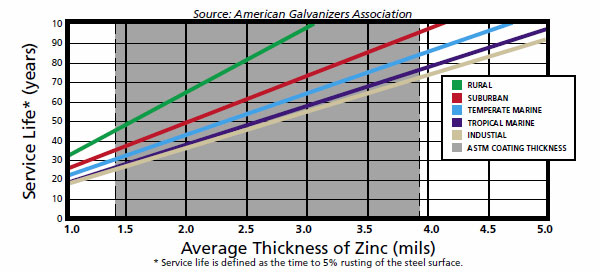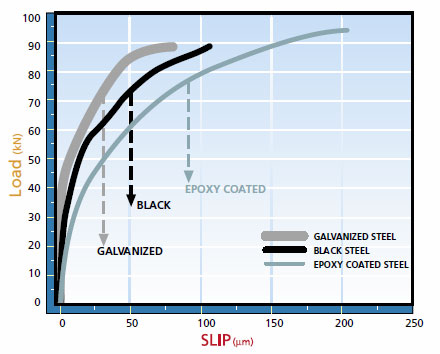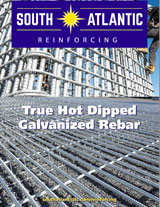- LONGER LIFE – Hot-dip galvanized steel resists corrosion in numerous environments extremely well. It is not uncommon for galvanized steel to last more than 70 years under certain conditions.* (See the Service Life Chart below.)
- SELF-HEALING – The unique chemistry of zinc galvanizing actually reacts in the presence of water to create rust-resistance at the point of any surface damage.
- TOUGHER THAN STEEL – The galvanizing process creates alloy layers on the surface that are actually harder than many base steels.*
- MINIMIZES RETOUCHING ON THE JOB SITE – Saves time and troubles involved with patching gaps, job site damage, and imperfections that occur in other types of rust-proofing.
- SUPERIOR BOND STRENGTH – In studies conducted by the University of California in accordance with American Concrete Institute, galvanized reinforcing bar showed superior bond strength compared to both black and epoxy-coated rebar.* (See the Bond Strength Chart.)
- COST-EFFECTIVE – When compared with paint systems, hot-dip galvanizing has comparable initial application costs and, almost always, lower life-cycle costs. In fact, the lower life-cycle costs of a hot-dip galvanized project make galvanizing the smart choice for today and tomorrow.*
The Service Life Chart (SLC) was developed based on decades of corrosion rate data collected from galvanized steel samples exposed to the environments in cities all over the world, and a corrosion prediction model based on statistical methods and neural network technology.
The data points of the SLC are based on macroscopic environmental data and, thus may vary from the actual corrosion rate observed due to site-specific environmental conditions.
The chart above is for galvanized coatings in various atmospheres, not embedded in concrete. A clear example of the service life of galvanized coatings can be found in existing bridges in corrosive environments that have been in service for more than 50 years and still have more than the minimum coating weight intact on the rebar.
Atmospheric levels of relative humidity, sulfur dioxide, airborne salinity, precipitation, and temperature influence actual corrosion rates in a specific geographic location.
Parameters such as wind direction, frequency drying, alloying composition, and surface orientation may also affect corrosion rates, but because of their variable and usually minor nature, are not included in the SLC model.
How Long Will Galvanized Coatings Last?
Galvanized Reinforcing Service Life Chart

How Well Does Galvanized Rebar Hold?

Studies have shown that the bond between galvanized steel and concrete is as good as or better than black steel in concrete.
* Source: American Galvanizers Association

